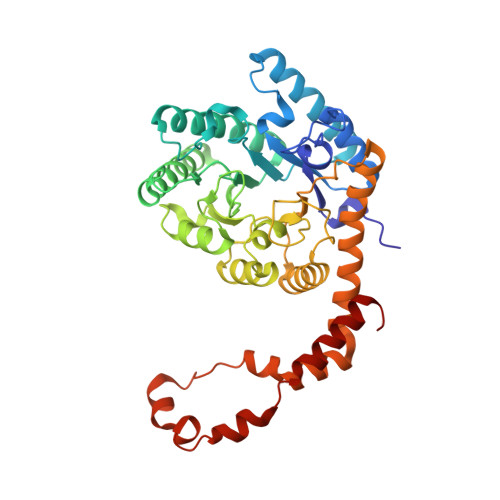Xylose isomerase in substrate and inhibitor michaelis States: atomic resolution studies of a metal-mediated hydride shift(,).
Fenn, T.D., Ringe, D., Petsko, G.A.(2004) Biochemistry 43: 6464-6474
- PubMed: 15157080
- DOI: https://doi.org/10.1021/bi049812o
- Primary Citation of Related Structures:
1S5M, 1S5N - PubMed Abstract:
Xylose isomerase (E.C. 5.3.1.5) catalyzes the interconversion of aldose and ketose sugars and has an absolute requirement for two divalent cations at its active site to drive the hydride transfer rates of sugar isomerization. Evidence suggests some degree of metal movement at the second metal site, although how this movement may affect catalysis is unknown. The 0.95 A resolution structure of the xylitol-inhibited enzyme presented here suggests three alternative positions for the second metal ion, only one of which appears positioned in a catalytically competent manner. To complete the reaction, an active site hydroxyl species appears appropriately positioned for hydrogen transfer, as evidenced by precise bonding distances. Conversely, the 0.98 A resolution structure of the enzyme with glucose bound in the alpha-pyranose state only shows one of the metal ion conformations at the second metal ion binding site, suggesting that the linear form of the sugar is required to promote the second and third metal ion conformations. The two structures suggest a strong degree of conformational flexibility at the active site, which seems required for catalysis and may explain the poor rate of turnover for this enzyme. Further, the pyranose structure implies that His53 may act as the initial acid responsible for ring opening of the sugar to the aldose form, an observation that has been difficult to establish in previous studies. The glucose ring also appears to display significant segmented disorder in a manner suggestive of ring opening, perhaps lending insight into means of enzyme destabilization of the ground state to promote catalysis. On the basis of these results, we propose a modified version of the bridged bimetallic mechanism for hydride transfer in the case of Streptomyces olivochromogenes xylose isomerase.
Organizational Affiliation:
Department of Biochemistry, Graduate Program in Biophysics, Rosenstiel Basic Medical Sciences Research Center, Brandeis University, Waltham, Massachusetts 02454-9110, USA.

















